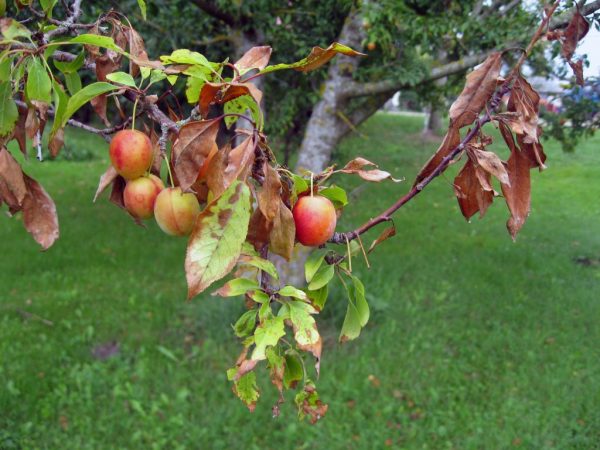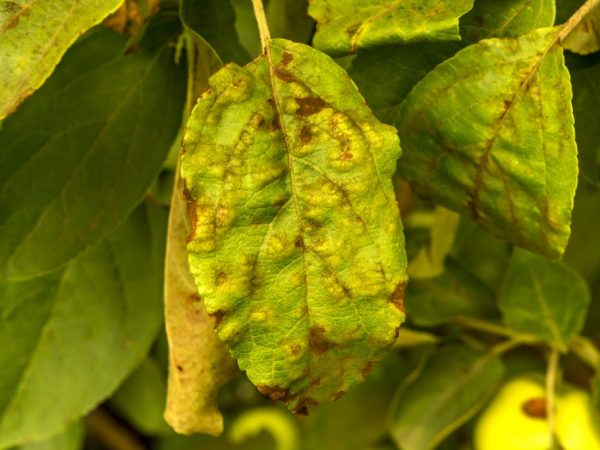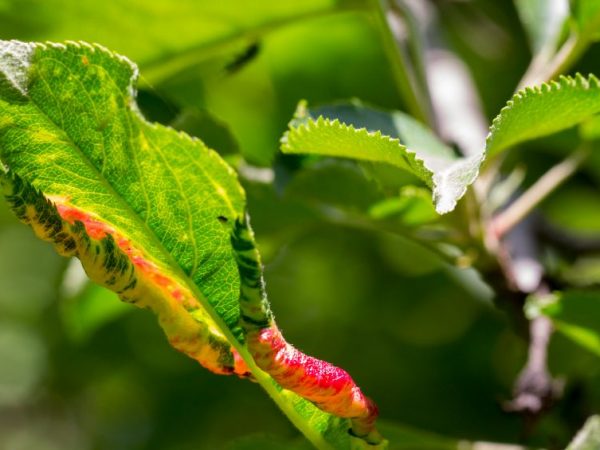Treatment of a bacterial burn of an apple tree
A bacterial burn of an apple tree is an infectious disease that can destroy an apple orchard in 1-2 seasons.
- Etiology and symptoms
- Foliage
- Escapes
- Inflorescences and fruits
- Distribution mechanism
- Contributing factors and allies of bacteria
- Chemicals in the treatment of bacteriosis
- Folk remedies in the treatment of bacteriosis
- Acid
- Ash
- Baker's yeast
- Sapropel
- Biological agents in the treatment of bacteriosis
- Stimic
- Baikal-EM1
- Shining-1
- Preventive measures against bacteriosis
- Frequent mistakes in the treatment of bacteriosis
- Conclusion

Treatment of a bacterial burn of an apple tree
Etiology and symptoms
The causative agent of fire blight is a gram-negative, motile bacterium, Ervinia, originally from America.
Outwardly, it is a single rods driven by flagella or collected in chains 0.7-0.1 * 0.9-1.5 microns in size. It affects cultivated and wild plants.
Ervinia came to European countries by the middle of the 20th century. In Russian gardening, they first encountered it in Kaliningrad, Karachay-Cherkessia, Samara, Saratov, Tambov, Belgorod and Voronezh.
Hawthorn, apple, mountain ash, quince are susceptible to the disease, pear and dogwood show the least antibacterial resistance.
An infectious disease has characteristic signs that appear on damaged vegetative parts.
Foliage
Under the influence of infection, the foliage between the veins is covered with necrotic foci of a reddish color, gradually spreading to the peripheral region.
Escapes
Dry top is observed in young processes. When the infection is activated, they wither, bending in the form of a hook. Sunburned apple shoots die off, remaining straight in shape.
Inflorescences and fruits
The burn covers the inflorescences, which acquire a dark color and subsequently die. Darkened ovaries stop developing. Apples become covered with cloudy secretions - milky-white exudate that turns brown in the air, subsequently mummified.
With a sunburn, the buds and inflorescences do not change their color, and when infected with Erwinia, apples and inflorescences do not fall off for a year or more.
Distribution mechanism
The bacterial bacillus hibernates in the affected wood, and with the beginning of sap flow, in the spring, it begins active reproduction, appearing on the surface of the bark along with exudate.
The penetration of ervinia into tissue cells occurs through damage to the tree bark - frost holes, mechanical wounds due to pruning, violation of the integrity of foliage and apples.
During the flowering stage, pollinating insects, birds and pests carry infectious exudate to the inflorescences of healthy apple trees. Thus, the disease continues to spread with flower nectar and through the peduncle, penetrating into the conducting vessels.
Distribution through the tissues of organs occurs through the vascular system and leads to systemic damage to the tree.

Bactria spread very quickly
Contributing factors and allies of bacteria
The spread of infection is facilitated by prolonged rains at moderate temperatures, including a rise to 20 ° and above and an excess of 70% humidity.With the onset of hot summer weather, the development of Erwinia slows down and re-enters the active stage in the fall.
Parasitic microorganisms contribute to the intensive spread of the bacterial bacillus:
- fungus - the causative agent of moniliosis, damaging pistil cells and facilitating the penetration of ervinia;
- gram-negative pseudomone - bacillus, destroying the hard integumentary epithelium, through which the introduction of a bacterial bacillus is difficult.
Chemicals in the treatment of bacteriosis
Infections with bacterial etiology are treated with medications from the antibiotic group:
- ampicillin - 1 ampoule per 10 liters of water, applicable for spraying throughout the growing season;
- phytolavin - 20 ml per 10 liters of water, applicable for wood processing and watering in the area of the trunk circle;
- tetracycline (3 tablets) with streptomycin (1 ampoule of 500 thousand units) for 5 liters of water, are applicable for spraying before, during and at the end of the flowering stage until the apples ripen;
- gentamicin - 1 ampoule per 1 liter of water, is applicable for soaking a garden bandage, which is used to tie previously cleaned areas of damage to the tree bark that have exudate secretions;
- ofloxacin - 2 tab. 10 water, suitable for spraying before and after the flowering stage.
Antibiotics are used in the treatment of bacterial burns in combination with fungicidal agents. often the infection is accompanied by concomitant fungal diseases. Skor, Ridomil-gold, Acroba and the like are recommended as fungicides for complex treatment.
Folk remedies in the treatment of bacteriosis
It is not effective to treat a bacterial burn with folk remedies alone, but they can act as an additional therapy to help cope with the infection.
Acid
Boric and succinic acids create an acidic environment that increases the overall resistance of trees. For spraying, make an aqueous solution of 10 liters of water:
- 10 g boric acid or
- 10 tab. succinic acid.
Ash
The use of solutions based on wood ash increases the functioning of the immune system of apple trees by increasing the content of potassium and phosphorus in them.
Recipe: 200 g of ash, diluted in 10 liters of water.
Baker's yeast
Nutritional yeast has an inhibitory effect on bacterial microorganisms and stimulates plant growth.
Recipe: 10 g yeast, 2 tbsp. granulated sugar is dissolved in 10 liters of heated water, kept for 2 hours and the damaged trees are sprayed.
Sapropel
It has the ability to cleanse soil from pathogenic bacteria, feeding the garden culture with potassium and phosphorus. It is used in the form of mulch in a layer of 5-7 cm.
Biological agents in the treatment of bacteriosis

Treatment should be started immediately
An additional measure in the fight against bacteriosis is the use of compositions of a biological spectrum of action in combination with antibiotics and folk remedies. They saturate the soil and apple trees with useful flora, strengthening and healing the land and garden culture.
Stimic
A drug with a biological spectrum of action that enhances metabolic processes, neutralizes the harmful effects of toxic substances and acts as an immunomodulator.
Applied in different forms:
- concentrate - 100 ml per 10 liters of water, intended for watering a garden culture at the end of the harvest;
- standard - 50 ml per 10 liters of water, applicable for spraying on apple leaves up to 7 times during the growing season with intervals between treatments of 14 days;
- phytostim - 50 ml per 10 liters of water, intended for watering once every 30 days.
Baikal-EM1
Biological preparation Baikal-EM1 is an immunostimulant and antidote. Used for spraying.
Recipe: 10 ml per 10 liters of water. The frequency of application is 3 times per weight during the growing season.
Shining-1
Shining-1 refers to the means of restoring the microflora of soil. Designed for spring watering.
Recipe: 1 bag for 0.5 liters of water, the dissolved active substance (10 ml) is diluted in 10 liters of water.
Preventive measures against bacteriosis

Be sure to treat the wood regularly
The best measure to combat bacterial burns of apple trees is preventive therapy and agricultural technology:
- active use of fertilizing complexes, among the components of which are present in an increased proportion of phosphorus and potassium, these components improve the resistance of fruit trees to phytopathogenic microorganisms;
- use for planting healthy seedlings;
- selection of varieties resistant to bacteriosis;
- prevention of thickening, thinning of tree crowns;
- disinfection of technical equipment used for pruning and grafting;
- timely removal of infected leaves and apples;
- pruning infected shoots to a length with the capture of a healthy area of at least 0.2 m;
- regular treatment of horticultural crops from pests.
Among the physical phytosanitary measures is the uprooting of wild crops that are most often exposed to contamination.
Frequent mistakes in the treatment of bacteriosis
In the fight against a bacterial burn, gardeners often make a number of typical mistakes that lead to complications in the treatment of apple trees.
The most common:
- Incorrect diagnosis. Often, signs of bacteriosis are perceived as symptoms of tree drying out due to insufficient watering. Starting with abundant watering in the absence of a correct diagnosis of a bacterial burn, they provoke the intensive development of the bacillus.
- In the treatment of bacteriosis, some begin to use fungicidal preparations, the action of which is aimed at destroying infections of fungal etiology. But ervinia belongs to bacteria - and the effect of antifungal fungicides for it is not destructive.
- Improper care. In the process of caring for the affected tree, especially in gardens with tall varieties, the maintenance of which is difficult due to their height, bacteria affected by the fruits are left on the tops of the crowns. However, the infested apples are reservoirs for the conservation of Erwinia throughout the winter. After that, the stick penetrates into the tissues and organs of the tree through the stalk.
Conclusion
Bacteriosis can damage the apple tree, leading to complete destruction in 1-2 seasons. It is treated with antibiotics in combination with fungicides. often accompanied by fungal diseases. Folk and biological remedies can be used as additional therapy.

